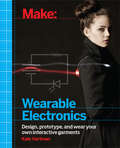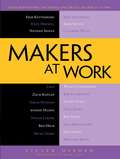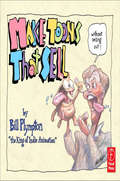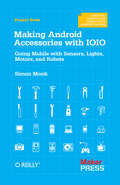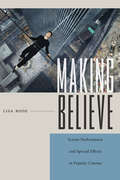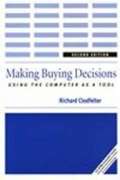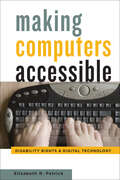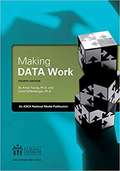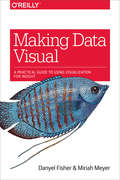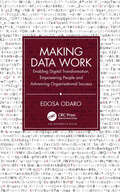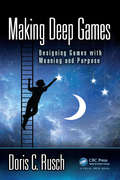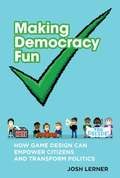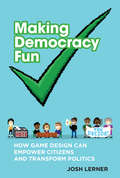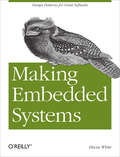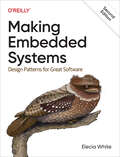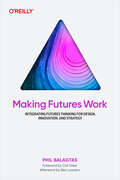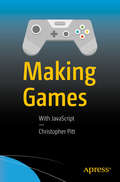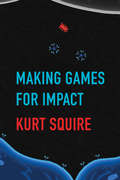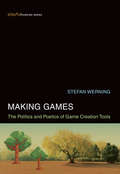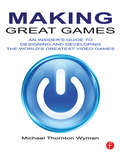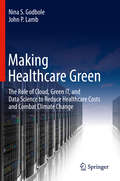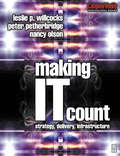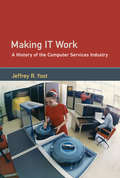- Table View
- List View
Make: Wearable Electronics
by Kate HartmanWhat if your clothing could change color to complement your skin tone, respond to your racing heartbeat, or connect you with a loved one from afar? Welcome to the world of shoes that can dynamically shift your height, jackets that display when the next bus is coming, and neckties that can nudge your business partner from across the room. Whether it be for fashion, function, or human connectedness, wearable electronics can be used to design interactive systems that are intimate and engaging. Make: Wearable Electronics is intended for those with an interest in physical computing who are looking to create interfaces or systems that live on the body. Perfect for makers new to wearable tech, this book introduces you to the tools, materials, and techniques for creating interactive electronic circuits and embedding them in clothing and other things you can wear. Each chapter features experiments to get you comfortable with the technology and then invites you to build upon that knowledge with your own projects. Fully illustrated with step-by-step instructions and images of amazing creations made by artists and professional designers, this book offers a concrete understanding of electronic circuits and how you can use them to bring your wearable projects from concept to prototype.
Makers at Work
by Steven OsbornWhat do you get when you combine an electronics hobbyist, hacker, garage mechanic, kitchen table inventor, tinkerer, and entrepreneur? A "maker," of course. Playful and creative, makers are--through expertise and experimentation--creating art, products, and processes that change the way we think and interact with the world. As you''ll see from the 21 interviews in Makers at Work, inquisitive makers are just as apt to pick up a laser cutter or an Arduino as a wrench to fashion something new. For example, you''ll meet Jeri Ellsworth, who might provide a video lecture on magnetic logic one day and a tutorial on welding a roll bar on a stock car the next. You''ll also meet Eben Upton, who put cheap, powerful computing in the hands of everyone with the Raspberry Π Becky Stern, who jazzes up clothing with sensors and LEDs; and bunnie Huang, who knows the ins and outs of the Shenzhen, China, electronics parts markets as well as anyone. As all the interviews in Makers at Work show, makers have something in common: reverence for our technical past coupled with an aversion to convention. If they can''t invent new processes or products, it''s simply not worth doing. Crazy as foxes, makers--working in the spirit of Tesla, Wozniak, Edison, Gates, Musk and many others--can bring sophisticated products to the people or to the market as fast or faster than large corporations. And they are not just enabling new technologies and devices--they are changing the way these devices are funded, manufactured, assembled, and delivered. Makers at Work puts a spotlight on the maker mindset and motivation of those who are reinventing the world one object or idea at a time. You will: Meet the individuals who define what it means to be a maker. Learn about the tools and technologies driving the new industrial revolution. Discover ways to scale your weekend project into a profitable business. See how others have used to crowdfunding to make their visions a reality. Learn how open-source hardware and software is enabling whole new categories of products by removing barriers of entry for inventors. The new masters of the "Makerverse" ask two questions: Can it be done? Is it fun? As these interviews will show, the answer to both questions is, "Let''s find out. " What you''ll learn You will: Learn about 3d printing and how it is changing manufacturing. Discover new software tools for designing things on your own. Learn how to source parts, code, or ideas for your creations. Meet maker pioneers who helped open up a new world, and makers who have used crowdfunding to support their efforts. Uncover recipes for success or failure when bringing physical products to market. Learn ways to scale your weekend project into a profitable business from experienced entrepreneurs. Learn how open-source hardware and software is enabling new classes of products by removing the barrier of entry for inventors. Open your mind to new ideas, methods, things, and possibilities. Who this book is for This book is for anyone with an independent spirit, creative bent, or natural curiosity who believes you can create whatever your mind can conceive and wants to see how others have done just that. Table of Contents Erik Kettenburg, Founder, Digistump David Merrill, Cofounder, Sifteo Nathan Seidle, CEO, SparkFun Electronics Laen, Founder, OSH Park Zach Kaplan, Founder and CEO, Inventables Emile Petrone, Founder, Tindie bunnie Huang, Founder, bunnie studios Natan Linder, Founder, FormLabs Ben Heck, Host, The Ben Heck Show Becky Stern, Director of Wearable Electronics, Adafruit Industries Eric Stackpole, Cofounder, OpenROV Eben Upton, Founder, Raspberry Pi Foundation Catarina Mota, Founder, OpenMaterials. org Ward Cunningham, Inventor, Wiki Jeri Ellsworth, Founder, Technical Illusions Sylvia Todd, Maker, Sylvia''s Super Awesome Maker Show! Dave Jones, Host, EEVBlog Bre Pettis, CEO, MakerBot Eric Migicovsky, CEO, Pebble Technology Ian Lesnet, Slashdot Troll, Dangerous Prototypes Massimo Banzi, Cofounder, Arduino
Making 'Toons That Sell Without Selling Out: The Bill Plympton Guide to Independent Animation Success
by Bill PlymptonLearn the secrets behind independent animation from the "The King of Independent Animation" - Academy Award-nominated Bill Plympton. This living legend breaks down how to make a career outside of the world of corporate animation - and without compromise. Learn time-saving techniques, the secrets to good storytelling, and the business-side of short and feature-length animation films.
Making Android Accessories with IOIO
by Simon MonkCreate your own electronic devices with the popular IOIO ("yoyo") board, and control them with your Android phone or tablet. With this concise guide, you'll get started by building four example projects--after that, the possibilities for making your own fun and creative accessories with Android and IOIO are endless. To build Android/IOIO devices, you write the program on your computer, transfer it to your Android, and then communicate with the IOIO via a USB or Bluetooth connection. The IOIO board translates the program into action. This book provides the source code and step-by-step instructions you need to build the example projects. All you have to supply is the hardware. Learn your way around the IOIO and discover how it interacts with your Android Build an intruder alarm that sends a text message when it detects movement Make a temperature sensing device that logs readings on your Android Create a multicolor LED matrix that displays a Space Invader animation Build an IOIO-powered surveillance rover that you control with your Android Get the software and hardware requirements for creating your own Android/IOIO accessories
Making Android Accessories with IOIO: Going Mobile with Sensors, Lights, Motors, and Robots
by Simon MonkCreate your own electronic devices with the popular IOIO ("yoyo") board, and control them with your Android phone or tablet. With this concise guide, you’ll get started by building four example projects—after that, the possibilities for making your own fun and creative accessories with Android and IOIO are endless.To build Android/IOIO devices, you write the program on your computer, transfer it to your Android, and then communicate with the IOIO via a USB or Bluetooth connection. The IOIO board translates the program into action. This book provides the source code and step-by-step instructions you need to build the example projects. All you have to supply is the hardware.Learn your way around the IOIO and discover how it interacts with your AndroidBuild an intruder alarm that sends a text message when it detects movementMake a temperature sensing device that logs readings on your AndroidCreate a multicolor LED matrix that displays a Space Invader animationBuild an IOIO-powered surveillance rover that you control with your AndroidGet the software and hardware requirements for creating your own Android/IOIO accessories
Making Believe: Screen Performance and Special Effects in Popular Cinema
by Lisa BodeIn the past twenty years, we have seen the rise of digital effects cinema in which the human performer is entangled with animation, collaged with other performers, or inserted into perilous or fantastic situations and scenery. Making Believe sheds new light on these developments by historicizing screen performance within the context of visual and special effects cinema and technological change in Hollywood filmmaking, through the silent, early sound, and current digital eras. Making Believe incorporates North American film reviews and editorials, actor and crew interviews, trade and fan magazine commentary, actor training manuals, and film production publicity materials to discuss the shifts in screen acting practice and philosophy around transfiguring makeup, doubles, motion capture, and acting to absent places or characters. Along the way it considers how performers and visual and special effects crew work together, and struggle with the industry, critics, and each other to define the aesthetic value of their work, in an industrial system of technological reproduction. Bode opens our eyes to the performing illusions we love and the tensions we experience in wanting to believe in spite of our knowledge that it is all make believe in the end.
Making Buying Decisions: Using the Computer as a Tool (2nd edition)
by Richard ClodfelterDesigned for use in a buying course with a heavy math emphasis, activities involve the student solving merchandising problems by using computerized spreadsheets. This manual is designed to accompany the text Retail Buying, 2nd edition, also by Richard Clodfelter.
Making Computers Accessible: Disability Rights and Digital Technology
by Elizabeth R. PetrickThe revolution in accessible computer technology was fueled by disability activism, the interactive nature of personal computers, and changing public policy.In 1974, not long after developing the first universal optical character recognition technology, Raymond Kurzweil struck up a conversation with a blind man on a flight. Kurzweil explained that he was searching for a use for his new software. The blind man expressed interest: One of the frustrating obstacles that blind people grappled with, he said, was that no computer program could translate text into speech. Inspired by this chance meeting, Kurzweil decided that he must put his new innovation to work to "overcome this principal handicap of blindness." By 1976, he had built a working prototype, which he dubbed the Kurzweil Reading Machine.This type of innovation demonstrated the possibilities of computers to dramatically improve the lives of people living with disabilities. In Making Computers Accessible, Elizabeth R. Petrick tells the compelling story of how computer engineers and corporations gradually became aware of the need to make computers accessible for all people. Motivated by user feedback and prompted by legislation such as the Americans with Disabilities Act, which offered the promise of equal rights via technological accommodation, companies developed sophisticated computerized devices and software to bridge the accessibility gap. People with disabilities, Petrick argues, are paradigmatic computer users, demonstrating the personal computer’s potential to augment human abilities and provide for new forms of social, professional, and political participation. Bridging the history of technology, science and technology studies, and disability studies, this book traces the psychological, cultural, and economic evolution of a consumer culture aimed at individuals with disabilities, who increasingly rely on personal computers to make their lives richer and more interconnected.
Making DATA Work
by Ph. D. Anita Young Carol KaffenbergerMaking DATA Work: An ASCA National Model Publication
Making Data Visual: A Practical Guide to Using Visualization for Insight
by Danyel Fisher Miriah MeyerYou have a mound of data front of you and a suite of computation tools at your disposal. Which parts of the data actually matter? Where is the insight hiding? If you’re a data scientist trying to navigate the murky space between data and insight, this practical book shows you how to make sense of your data through high-level questions, well-defined data analysis tasks, and visualizations to clarify understanding and gain insights along the way.When incorporated into the process early and often, iterative visualization can help you refine the questions you ask of your data. Authors Danyel Fisher and Miriah Meyer provide detailed case studies that demonstrate how this process can evolve in the real world.You’ll learn:The data counseling process for moving from general to more precise questions about your data, and arriving at a working visualizationThe role that visual representations play in data discoveryCommon visualization types by the tasks they fulfill and the data they useVisualization techniques that use multiple views and interaction to support analysis of large, complex data sets
Making Data Work: Enabling Digital Transformation, Empowering People and Advancing Organisational Success
by Edosa OdaroIf you care about AI transformation, empowering people or advancing organisational success in an increasingly digital world, then you should read this book.—Yomi Ibosiola, Chief Data and Analytics Officer, Union Bank A retail giant already struggling due to the Covid-19 pandemic was faced with a disastrous situation when—at the end of a critical investment in an artificial intelligence project that had been meant to save money—it suddenly discovered that its implementation was likely to leave it worse off. An entire critical service stream within an insurer’s production system crashed. This critical failure resulted in the detentions of fully insured motorists for allegedly not carrying required insurance. Making Data Work: Enabling Digital Transformation, Empowering People and Advancing Organisational Success details these two scenarios as well as others illustrating the consequences that arise when organizations do not know how to make data work properly. It is a journey to determine what to do to "make data work" for ourselves and for our organisations. It is a journey to discover how to bring it all together so organisations can enable digital transformation, empower people, and advance organisational success. It is the journey to a world where data and technology finally live up to the hype and deliver better human outcomes, where artificial intelligence can move us from reacting to situations to predicting future occurrences and enabling desirable possibilities.
Making Deep Games: Designing Games with Meaning and Purpose
by Doris C. RuschLike movies, television, and other preceding forms of media, video games are undergoing a dynamic shift in its content and perception. While the medium can still be considered in its infancy, the mark of true artistry and conceptual depth is detectable in the evolving styles, various genres and game themes. Doris C. Rusch’s, Making Deep Games, combines this insight along with the discussion of the expressive nature of games, various case studies, and hands-on design exercises. This book offers a perspective into how to make games that tackle the whole bandwidth of the human experience; games that teach us something about ourselves, enable thought-provoking, emotionally rich experiences and promote personal and social change. Grounded in cognitive linguistics, game studies and the reflective practice of game design, Making Deep Games explores systematic approaches for how to approach complex abstract concepts, inner processes, and emotions through the specific means of the medium. It aims to shed light on how to make the multifaceted aspects of the human condition tangible through gameplay experiences.
Making Democracy Fun
by Josh LernerAnyone who has ever been to a public hearing or community meeting would agree that participatory democracy can be boring. Hours of repetitive presentations, alternatingly alarmist or complacent, for or against, accompanied by constant heckling, often with no clear outcome or decision. Is this the best democracy can offer? In Making Democracy Fun, Josh Lerner offers a novel solution for the sad state of our deliberative democracy: the power of good game design. What if public meetings featured competition and collaboration (such as team challenges), clear rules (presented and modeled in multiple ways), measurable progress (such as scores and levels), and engaging sounds and visuals? These game mechanics would make meetings more effective and more enjoyable -- even fun. Lerner reports that institutions as diverse as the United Nations, the U.S. Army, and grassroots community groups are already using games and game-like processes to encourage participation. Drawing on more than a decade of practical experience and extensive research, he explains how games have been integrated into a variety of public programs in North and South America. He offers rich stories of game techniques in action, in children's councils, social service programs, and participatory budgeting and planning. With these real-world examples in mind, Lerner describes five kinds of games and twenty-six game mechanics that are especially relevant for democracy. He finds that when governments and organizations use games and design their programs to be more like games, public participation becomes more attractive, effective, and transparent. Game design can make democracy fun -- and make it work.
Making Democracy Fun: How Game Design Can Empower Citizens and Transform Politics (The\mit Press Ser.)
by Josh A. LernerDrawing on the tools of game design to fix democracy. Anyone who has ever been to a public hearing or community meeting would agree that participatory democracy can be boring. Hours of repetitive presentations, alternatingly alarmist or complacent, for or against, accompanied by constant heckling, often with no clear outcome or decision. Is this the best democracy can offer? In Making Democracy Fun, Josh Lerner offers a novel solution for the sad state of our deliberative democracy: the power of good game design. What if public meetings featured competition and collaboration (such as team challenges), clear rules (presented and modeled in multiple ways), measurable progress (such as scores and levels), and engaging sounds and visuals? These game mechanics would make meetings more effective and more enjoyable—even fun.Lerner reports that institutions as diverse as the United Nations, the U.S. Army, and grassroots community groups are already using games and game-like processes to encourage participation. Drawing on more than a decade of practical experience and extensive research, he explains how games have been integrated into a variety of public programs in North and South America. He offers rich stories of game techniques in action, in children's councils, social service programs, and participatory budgeting and planning. With these real-world examples in mind, Lerner describes five kinds of games and twenty-six game mechanics that are especially relevant for democracy. He finds that when governments and organizations use games and design their programs to be more like games, public participation becomes more attractive, effective, and transparent. Game design can make democracy fun—and make it work.
Making Embedded Systems: Design Patterns for Great Software
by Elecia WhiteInterested in developing embedded systems? Since they don't tolerate inefficiency, these systems require a disciplined approach to programming. This easy-to-read guide helps you cultivate a host of good development practices, based on classic software design patterns and new patterns unique to embedded programming. Learn how to build system architecture for processors, not operating systems, and discover specific techniques for dealing with hardware difficulties and manufacturing requirements. Written by an expert who's created embedded systems ranging from urban surveillance and DNA scanners to children's toys, this book is ideal for intermediate and experienced programmers, no matter what platform you use. Optimize your system to reduce cost and increase performance Develop an architecture that makes your software robust in resource-constrained environments Explore sensors, motors, and other I/O devices Do more with less: reduce RAM consumption, code space, processor cycles, and power consumption Learn how to update embedded code directly in the processor Discover how to implement complex mathematics on small processors Understand what interviewers look for when you apply for an embedded systems job "Making Embedded Systems is the book for a C programmer who wants to enter the fun (and lucrative) world of embedded systems. It's very well written--entertaining, even--and filled with clear illustrations." --Jack Ganssle, author and embedded system expert.
Making Embedded Systems: Design Patterns for Great Software
by Elecia WhiteInterested in developing embedded systems? Since they don't tolerate inefficiency, these systems require a disciplined approach to programming. This easy-to-read guide helps you cultivate good development practices based on classic software design patterns and new patterns unique to embedded programming. You'll learn how to build system architecture for processors, not for operating systems, and you'll discover techniques for dealing with hardware difficulties, changing designs, and manufacturing requirements.Written by an expert who has created systems ranging from DNA scanners to children's toys, this book is ideal for intermediate and experienced programmers, no matter what platform you use. This expanded second edition includes new chapters on IoT and networked sensors, motors and movement, debugging, data handling strategies, and more.Optimize your system to reduce cost and increase performanceDevelop an architecture that makes your software robust in resource-constrained environmentsExplore sensors, displays, motors, and other I/O devicesReduce RAM and power consumption, code space, and processor cyclesLearn how to interpret schematics, datasheets, and power requirementsDiscover how to implement complex mathematics and machine learning on small processorsDesign effective embedded systems for IoT and networked sensors
Making Friends on the Fly: Advances in Ad Hoc Teamwork
by Samuel BarrettThis book is devoted to the encounter and interaction of agents such as robots with other agents and describes how they cooperate with their previously unknown teammates, forming an Ad Hoc team. It presents a new algorithm, PLASTIC, that allows agents to quickly adapt to new teammates by reusing knowledge learned from previous teammates. PLASTIC is instantiated in both a model-based approach, PLASTIC-Model and a policy-based approach, PLASTIC-Policy. In addition to reusing knowledge learned from previous teammates, PLASTIC also allows users to provide expert-knowledge and can use transfer learning (such as the new Two Stage Transfer algorithm) to quickly create models of new teammates when it has some information about its new teammates. The effectiveness of the algorithm is demonstrated on three domains, ranging from multi-armed bandits to simulated robot soccer games.
Making Futures Work: Integrating Futures Thinking for Design, Innovation, and Strategy
by Phil BalagtasLearn how to get started with Futures Thinking. With this practical guide, Phil Balagtas, founder of the Design Futures Initiative and the global Speculative Futures network, shows you how designers and futurists have made futures work at companies such as Atari, IBM, Apple, Disney, Autodesk, Lufthansa, and McKinsey & Company.This book demystifies the process of Futures Thinking into a language that's practical and useful for both designers and strategists. You'll learn about Strategic Foresight for using ideas about the future to anticipate and prepare for change; explore Speculative Design to deal with the relationship between science, technology, and humans; and Design Fiction to explore and critique possible futures.Balagtas also shares stories from his journey to build a global community and describes how he works with clients to reshape the futures vocabulary. With this guide, you'll learn how to:Prepare your client, team, and/or audience for futuresFacilitate and work with the fundamental methods and frameworksGain advocacy and support within your organizationProvide measurable value from the process and outcomesBuild a futures culture and teamSustain a culture and support system beyond projects
Making Games
by Christopher PittDevelop games using the JavaScript web scripting language. This compact short book will help you learn how to use modern JavaScript to make games for web browsers. They're effortless to use and they work everywhere. If you've ever wanted to make a game, join author Christopher Pitt. You'll start with nothing and build fun games, in no time at all. What You'll Learn Make a game using JavaScript Master the game loop Handle player input, collision detection, gravity, ladders, and stairs Work with camera locking, mobs, and health Manage game inventory Handle mapping and more Who This Book Is For Those who are new to game development with some experience with JavaScript and web development.
Making Games for Impact
by Kurt SquireDesigning games for learning: case studies show how to incorporate impact goals, build a team, and work with experts to create an effective game.Digital games for learning are now commonplace, used in settings that range from K–12 education to advanced medical training. In this book, Kurt Squire examines the ways that games make an impact on learning, investigating how designers and developers incorporate authentic social impact goals, build a team, and work with experts in order to make games that are effective and marketable. Because there is no one design process for making games for impact—specific processes arise in response to local needs and conditions—Squire presents a series of case studies that range from a small, playable game created by a few programmers and an artist to a multimillion-dollar project with funders, outside experts, and external constraints. These cases, drawn from the Games + Learning + Society Center at the University of Wisconsin–Madison, show designers tackling such key issues as choosing platforms, using data analytics to guide development, and designing for new markets. Although not a how-to guide, the book offers developers, researchers, and students real-world lessons in greenlighting a project, scaling up design teams, game-based assessment, and more. The final chapter examines the commercial development of an impact game in detail, describing the creation of an astronomy game, At Play in the Cosmos, that ships with an introductory college textbook.
Making Games: The Politics and Poetics of Game Creation Tools (Playful Thinking)
by Stefan WerningAn argument that production tools shape the aesthetics and political economy of games as an expressive medium.In Making Games, Stefan Werning considers the role of tools (primarily but not exclusively software), their design affordances, and the role they play as sociotechnical actors. Drawing on a wide variety of case studies, Werning argues that production tools shape the aesthetics and political economy of games as an expressive medium. He frames game-making as a (meta)game in itself and shows that tools, like games, have their own "procedural rhetoric" and should not always be conceived simply in terms of optimization and best practices.
Making Great Games: An Insider's Guide to Designing and Developing the World's Greatest Games
by Michael Thornton WymanJoin videogame industry veteran Michael Thornton Wyman on a series of detailed, behind-the-scenes tours with the teams that have made some of the most popular and critically acclaimed videogames of the modern era. Drawing on insider's perspectives from a wide variety of teams, learn about the creation of a tiny, independent game project (World of Goo), casual game classics (Diner Dash, Bejeweled Twist), the world's most popular social game (FarmVille) as well as the world's most popular MMORPG (World of Warcraft), PC titles (Half Life 2) to AAA console games (Madden NFL 10), and modern-day masterpieces (Little Big Planet, Rock Band, Uncharted 2: Among Thieves). Hear directly from the creators about how these games were made, and learn from their stories from the trenches of videogames production. This book is an excellent resource for those working directly on game design or production, for those aspiring to work in the field, or for anyone who has wondered how the world's greatest videogames get made.
Making Healthcare Green: The Role of Cloud, Green IT, and Data Science to Reduce Healthcare Costs and Combat Climate Change
by Nina S. Godbole John P. LambThis book offers examples of how data science, big data, analytics, and cloud technology can be used in healthcare to significantly improve a hospital’s IT Energy Efficiency along with information on the best ways to improve energy efficiency for healthcare in a cost effective manner. The book builds on the work done in other sectors (mainly data centers) in effectively measuring and improving IT energy efficiency and includes case studies illustrating power and cooling requirements within Green Healthcare.Making Healthcare Green will appeal to professionals and researchers working in the areas of analytics and energy efficiency within the healthcare fields.
Making IT Count: Strategy, Delivery, Infrastructure (Computer Weekly Professional Ser.)
by Leslie Willcocks Nancy Olson Peter Petherbridge'Making IT Count: from strategy to implementation' focuses on the practical elements of delivering Information Technology strategy. Studies regularly show that over half of Information Technology strategies are never implemented, or are unsuccessful in delivering the desired results, and that a significant percentage of strategies implemented were never in the original plans. The linkage between strategy development and delivery needs a very clear focus; this is the key topic that the authors address. The book highlights eight major fallacies in managing IT, and eighteen better practices. It then details how to draw up strategy, instigate navigation techniques and make sourcing decisions. Change and delivery are a major focus, as is infrastructure development. Caselets and full length case studies of organizations such as General Electric, Siemens, Colonial Mutual, Charles Schwab, Macquarie Bank, ICI, United Airlines, Norwich Union, Walgreens and Dell and have been included to show how strategies have been successfully implemented and managed.
Making IT Work: A History of the Computer Services Industry (History of Computing)
by Jeffrey R. YostThe evolution of the multi-billion-dollar computer services industry, from consulting and programming to data analytics and cloud computing, with case studies of important companies.The computer services industry has worldwide annual revenues of nearly a trillion dollars and employs millions of workers, but is often overshadowed by the hardware and software products industries. In this book, Jeffrey Yost shows how computer services, from consulting and programming to data analytics and cloud computing, have played a crucial role in shaping information technology—in making IT work. Tracing the evolution of the computer services industry from the 1950s to the present, Yost provides case studies of important companies (including IBM, Hewlett Packard, Andersen/Accenture, EDS, Infosys, and others) and profiles of such influential leaders as John Diebold, Ross Perot, and Virginia Rometty. He offers a fundamental reinterpretation of IBM as a supplier of computer services rather than just a producer of hardware, exploring how IBM bundled services with hardware for many years before becoming service-centered in the 1990s.Yost describes the emergence of companies that offered consulting services, data processing, programming, and systems integration. He examines the development of industry-defining trade associations; facilities management and the firm that invented it, Ross Perot's EDS; time sharing, a precursor of the cloud; IBM's early computer services; and independent contractor brokerages. Finally, he explores developments since the 1980s: the transformations of IBM and Hewlett Packard; the offshoring of enterprises and labor; major Indian IT service providers and the changing geographical deployment of U.S.-based companies; and the paradigm-changing phenomenon of cloud service.
